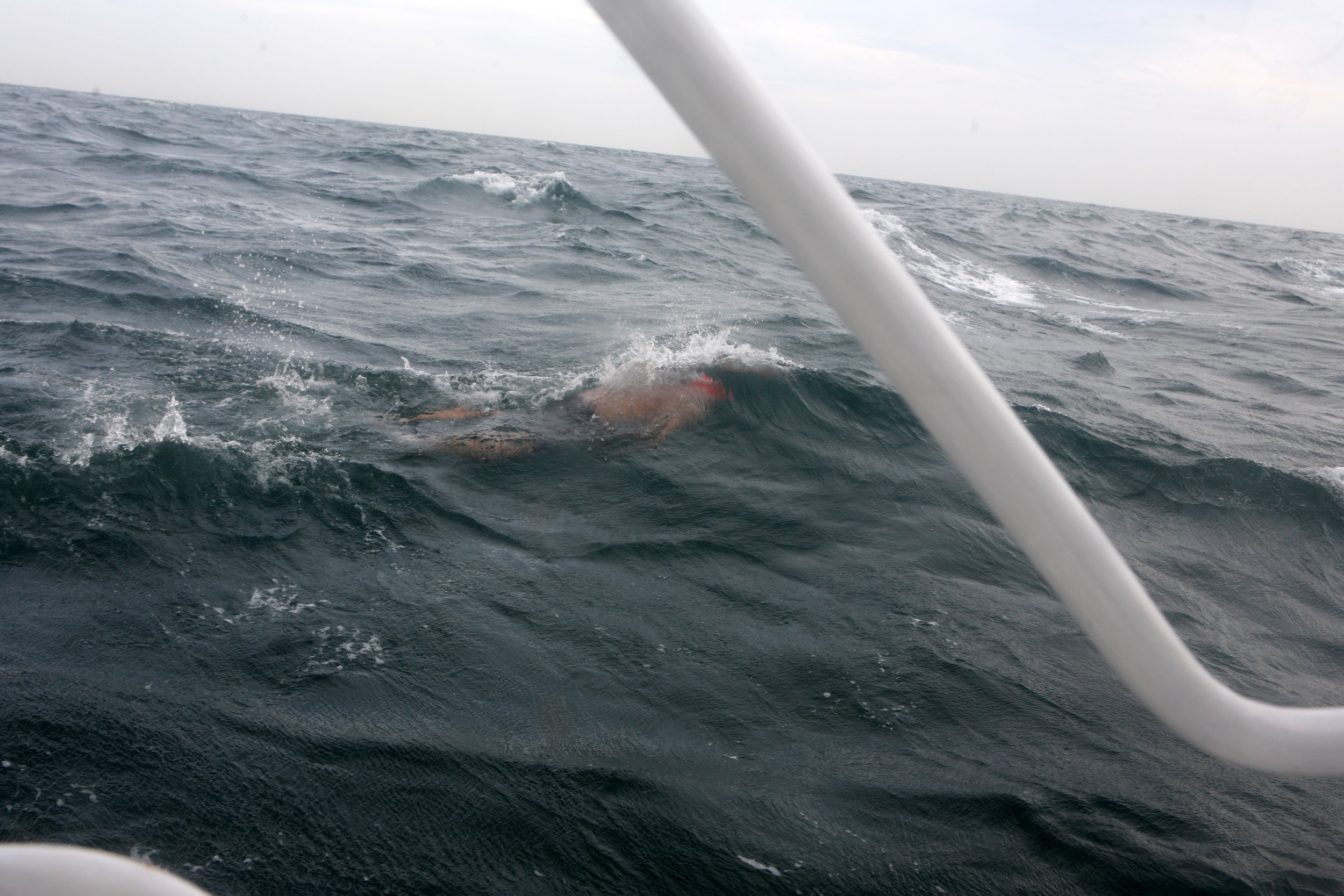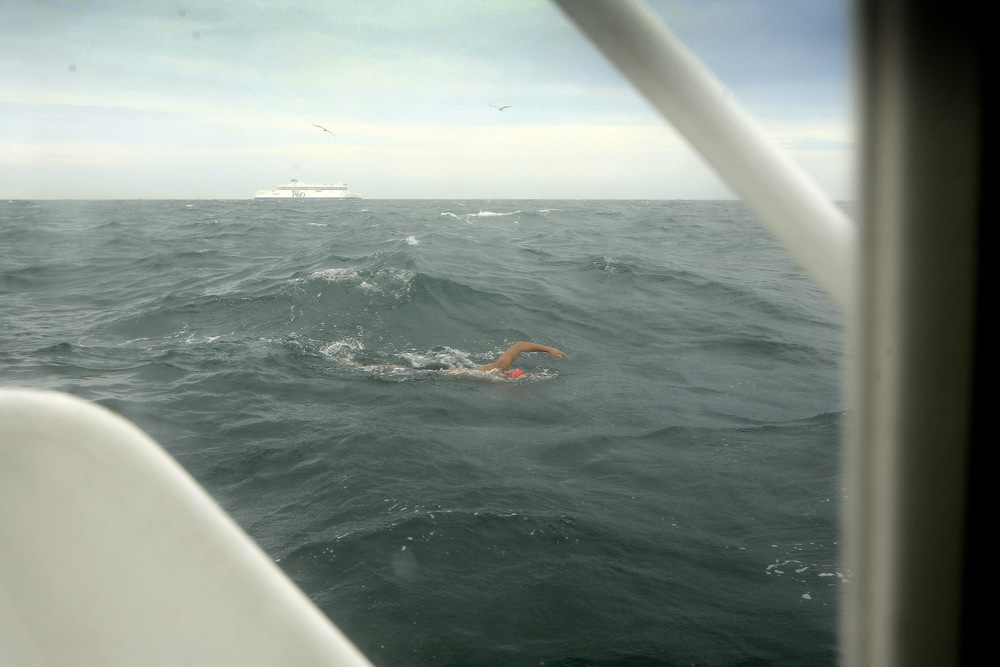
This is the second of a three-part series on Doug’s swim across the English Channel. Read part 1 here, and check back on Monday for part 3.
The English Channel Swim – how it begins
The swim actually starts from Shakespeare Beach, just a little south of Dover. The pilot boat can only get within 50 or 60 yards of the beach, so you jump off the back of the boat, you swim to shore, you stand on dry land (another one of those pesky Channel rules) and they blow the start horn when you give them a thumbs up sign. While on that beach, which is really more like graveI, I gathered my thoughts. I was buzzing from how quickly it had all come together (jet lag, perhaps?) but I had accepted the offer to go and felt like I had better deliver. I gave Lance the thumbs up, and he blew the air horn. I stepped into the water around 1:00 p.m.
From earlier blog posts, I have written about the fact that when I was a pool swimmer, I was really a butterfly specialist. From 25 yard events as a seven year old age-grouper to 200 meters as a college swimmer, butterfly was pretty much my thing. The other butterfly specialists I have known over the years are a pretty tight bunch, almost like a little fraternity. Each and every one asked if I would swim the Channel butterfly the whole way. It has been done, I told them, but it was not to be done by me. Having said that, I wanted to be able to say that I had swum butterfly in the English Channel, so the first three strokes were butterfly. So, if you are reading this – Bish, Bruce, Weasel, Freddie, Riz, Davey, BC, Port and Strokes – that was for you guys. Go ahead, fellas, try to top it.

And so, the swim began. We were out of Dover Harbor in what seemed like no time, and then came the waves that Lance had warned me about. I also learned what force 5 and force 6 mean; wind speeds of 20 mph or more. We had the difficult situation of the tide and the wind moving in opposite directions, which makes for very confused seas. When the wind is blowing force 5 – 6, it is very confused seas, with waves that top five feet. Five footers are not in themselves a huge problem, but the “confused” part is. There is no rhythm to the waves, and I just couldn’t get a consistent stroke cadence going. The feeling in one of just getting slapped around by the waves, taking in lots of seawater, and trying to keep on course. The challenge of swimming in choppy waves is to get through it without fighting the water and getting yourself beaten up too badly; after all, there is a lot of swimming to be done even once the waves dissipate.
Lance had said the wind would clock around and ultimately follow the tide, and make more rolling swells. Unfortunately, that didn’t happen either. Despite my efforts not to fight the water, my shoulders were really aching, I continued to swallow and breathe in a lot of seawater, and I felt like a carnival punching bag. All I could ask when I stopped for feeding was when the wind was going to turn, as though Lance and Chris would actually have answers. “Soon,” was all I could get.

The five-foot choppy waves were with us for 12 miles, probably about six hours. It was a real grind. We have chop like that in Lake Michigan – and we do get it there – but I have never spent that kind of extended time in conditions like that. The choppy water was having an effect on the crew on the boat, and they were sick as dogs. Susan, three of our kids, and our friend Meghan were on the boat and were busy the whole time, even when they were actively heaving over the side. In the water, I didn’t realize that they were having such trouble, but hearing the stories afterward, it was agony.

Finally, the wind dissipated to a force 4 (sub-20 mph) and came around a little to our favor. The five-footers became three-footers and, while that is still plenty choppy, it was a welcome contrast. Having said that, I never got to the point where the water was calm enough that I could use a lot of the body roll, “hip-driven” freestyle techniques that my trainer, Marcia Cleveland, has taught us, so I wasn’t able to minimize the strain on my shoulders. I was able to engage my legs a bit more, though I knew that my legs wouldn’t be along for the long term on this swim.
But, I Was Looking for a Challenge
The English Channel is a busy shipping lane; I am told that it is one of the busiest in the world, with some 600 commercial vessels up and down there every day. Fortunately, it was a Sunday, which may have made our trip a little more manageable. Other than two ferries, which were plenty big enough, I never saw any freighters or tankers. Susan saw several and took lots of pictures, but made a point of not pointing them out to me. The shipping lanes are quite orderly; there is a northbound lane on the west (England side), and a southbound shipping lane to the east, both of which are five miles wide. They are separated by a one-mile buffer zone, which is remarkable enough – it isn’t like they have lane markers or anything to make sure they don’t drift into the opposite lane.
I have a pesky problem that turned into a huge headache for my crew during the swim. It is very hard for me to swim straight, particularly after I start to get tired. One of the lingering effects of my herniated disc from last year is that I lost a lot of strength in my left arm, and I wasn’t able to fully re-develop it. Hence, I am a drift-left guy (is that a hook or a slice?) which led to a chronic process of me pulling away from the pilot boat to the left, then swimming back to the boat, only to drift off to the left again. It was frustrating for everyone on the boat and in the water, and it wasn’t until both arms were so tired that I was able to keep close to the boat better.
Hugging the boat was an issue, too, because it was terrifying. Lance’s pilot boat, the Sea Satin, is 40 feet long and is built as a sturdy fishing boat. Pitching around in the waves, and being just a few feet from that monster, made it constantly feel like the boat was about to fall on me. So, I kept a little distance. The distance meant that I swam farther. Oh, well; I will be dreaming about that boat pitching and rolling for a long time.
The Jellyfish Problem
Two issues I was concerned about before we left were totally uncontrollable, but I worried about them anyway. Cold and jellyfish. Jellyfish and cold. As it turns out, the water was 63F the whole time, and I never got cold. After midnight, it got a little chillier, probably because we lost a few air temperature degrees, but the cold was not an issue that I couldn’t deal with. My friend Mike Solberg swam the Channel two years ago, and uses the analogy of the cold to the monster in the closet; just don’t let that monster out, and everything will be ok.
Jellyfish are a different kind of problem. The Channel is famous for them. Another friend, John Meunzer, swam through a shoal of jellyfish in 2009 that was a mile wide. I had a bad experience with a jellyfish in Tampa Bay, and didn’t want to repeat it. We loaded up on the antihistamines ahead of time, but didn’t know what to expect. As it turns out, I only hit one, and it was a small one that stung my chest for a second and was gone. My crew saw a large one, the color of pink, and the size of a basketball. They did not report it to me.
As has been reported many times before in this blog, I count my strokes in open water swims. It is a little bizarre, almost like someone should stage some kind of an intervention; “Hi, my name is Doug, and I am a stroke counter.” Actually, it keeps my mind occupied, it keeps those annoying songs out of my head (why are they always have to be the annoying ones?), and it helps me keep track of time and distance traveled. Before the Channel swim, the longest I had gone was Tampa Bay, which was about 32,000 strokes. I had done the arithmetic for the English Channel, and had mentally prepared myself for 40,000 or so, hoping that conditions would be so terrific that I could get there with a few thousand less. As it turned out, conditions were a bit more rugged, so it all evened out. So, now we know – it takes 40,538 strokes to make it across the English Channel. We should probably write that down somewhere.
The feeding routine for this swim was the one we had adopted for the other long salt water swims we had done. Thirty minute cycles, which is about 1,750 strokes, stop for a few seconds and toss back some Infinit Nutrition liquid. My son Gordy was on the rail of the boat THE ENTIRE SWIM and was the chief bottle tosser for feedings, and they worked out very well. In fact, Gordy stepped up as only Gordy can, and was the real hero of this swim. He was protective, totally diligent, and did not get sick at sea. He tells me now that he actually took a couple of breaks to go to the head, but I swear that every time I looked up at that boat, Gord was standing there focused on me. Gordy’s quiet and unassuming manner belies the inner jokester and wing-man; this is a guy you want on your side.

As the day turned to night, Gord had Billy heat the water a bit before they fed me, which was a really nice warming lift. Once again, the Infinit product gave me enough carbohydrate and, while I was tired and sore at the end, I never ran out of gas. Boat pilots Lance and Chris were very critical of me for not using Maxim, the product that every other marathon swimmer uses, and couldn’t have cared less when I told them that Maxim didn’t agree with my system and that I had found a product that was even better. I wasn’t drinking the stuff for Lance and Chris, I decided, so let them be critical.
I am pretty inexperienced at swimming in the dark, and almost seven of the 14 hours it took for us to get across the Channel were in the dark. We had tested some theories in a night swim on Lake Zurich before we left, which taught us a few things. For example, putting a waterproof strobe light on your goggle strap makes a lot of sense. What we learned, though, is if you put the strobe on the back of the goggle strap, the swimmer is invisible if they are facing you. So, we attached two strobes, one to each side of the goggles, and it worked just great. The dark also changed the water. During the daylight, I was surprised to see the clarity of the water; I guess I had expected it to be murkier. After dark, though, the water was inky black. It wasn’t colder or more unpredictable, but just gives you this feeling of staring into infinity.
One of the best bits of news from the whole swim is that my neck was just fine. I was the grateful recipient of Medtronic’s Prestige Cervical disc a year and a half ago, and it held up like a champ. I never felt any pain, I was never aware of my little bionic device, and I hope that I was the first replacement disc mule across the English Channel. I guess everyone has to be first at something. Seriously, though, if not for that little replacement disc, this swim would have been incomprehensible, and I will forever be grateful to my friends at Medtronic for their technology and their support of A Long Swim.



